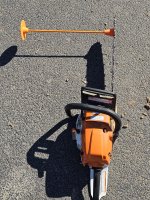I'm heating a very large and relatively inefficient 300 year old house with wood, and so maximizing how much wood I can pack into the stoves with each load really impacts how much oil I need to burn to supplement the stoves. For this reason, I try to make sure every split is within 1/2" of the ideal length to maximize what I'm getting out of every load.
But I'm also processing 10 full cords per year for my own use, and at one time that was as high as 14 cords per year, so I don't have time for any method that takes more than a second or two. What I settled on was this:
1. Cut a handy stick (I prefer dimensional 1x2 = 3/4" x 1-1/2") to your preferred split length (18" for me).
2. Wrap some masking tape around it in a spiral, and hit it with a few coats of fluorescent orange or other high-contrast marking paint, so you don't lose the damn thing. Stripes work well, as no matter the color, there are no stripes in the nature of my back yard.
3. Holding that stick in my left hand and my top-handle saw in my right, I walk down the length of each log I'm ready to buck, and "kiss" it with the top handle saw. Typical saw kerf is probably only 1/2" - 1" deep, it's just a very-indellible marking tool.
4. Set top handle saw and stick aside, grab a real saw, and buck away.
Some prefer chalk or paint, but I always find there are conditions (wet, snow, etc.) where neither work. The top handle saw makes a nice quick kerf mark that works as a mark in all weather.
